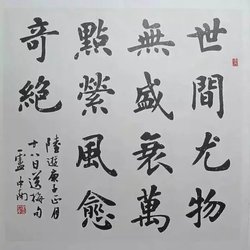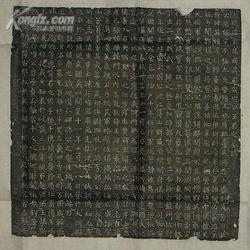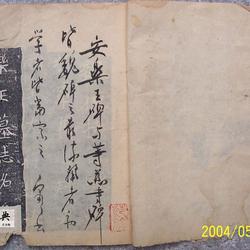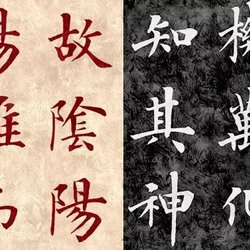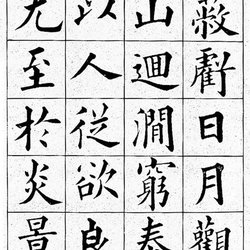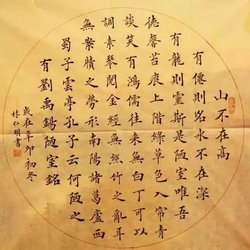The stele "Liquan Ming of Jiucheng Palace" was built in the sixth year of Zhenguan (AD 632). It was written by Wei Zheng and Ouyang Xunshu Dan. The inscription records that Emperor Taizong of the Tang Dynasty discovered the gushing spring when he was vacationing in Jiucheng Palace. This stele was commissioned by Ou Gong in his later years and has been regarded as one of the classic models by calligraphers of all ages.
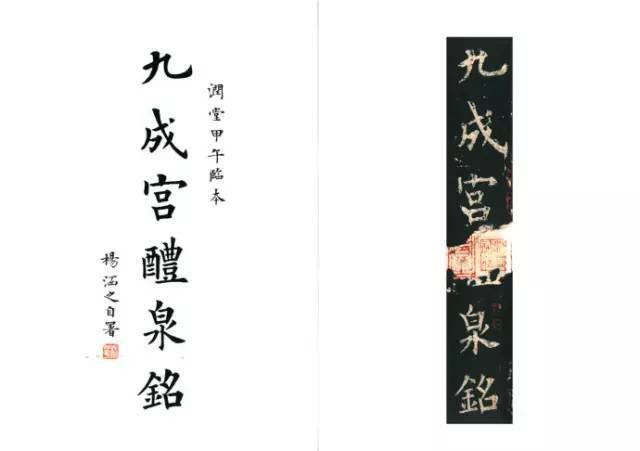
The ancients said that calligraphy in the Tang Dynasty "advocated the law", and "Jiucheng Palace Liquan Ming" is a concentrated expression of this "law". In fact, the so-called "law" is a rule-the rule of writing. As the ancients said, "If there are no rules, you can't make a circle." The stipple structure of "Jiucheng Palace Liquan Ming" has obvious patterns, and beginners of calligraphy can easily benefit from it. This is why many teachers regard this calligraphy as the first choice copybook for learning calligraphy.
So, why do many people who are new to "Jiucheng Palace Liquan Ming" feel that after practicing to a certain stage and basically mastering writing, they will have problems such as "it is difficult to make progress" and "it is easy to write the words to death"...? This is also caused by the "standards" in the copybooks. If you are not good at learning, you will be bound by the "Dharma", resulting in your written words being lifeless and looking like arithmetic. This is the result of not being good at learning the "Dharma" and using the "Dharma".
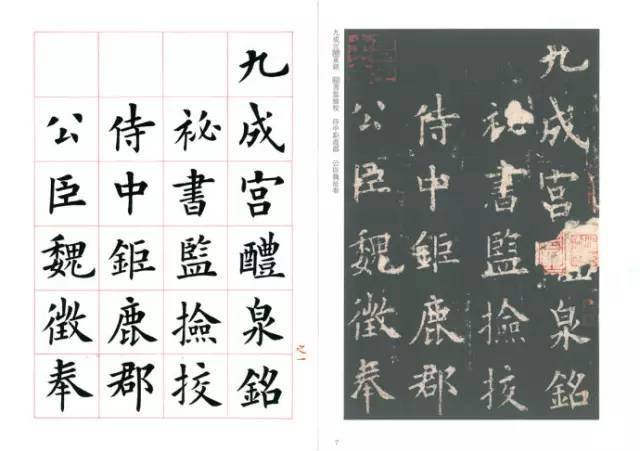
How to read Xi Ouyang Xun's "Jiucheng Palace Liquan Ming"? I think the basic learning process should be "discovery - practice - memory". The following is a detailed description of the learning methods at each stage:
|一|Discovery
What we call "discovery" here can be understood as the process of "reading posts". Reading posts is a very important preparation activity before posting. Scholars since ancient times regard reading posts as the simplest, most convenient and feasible means of learning. It is not a general appreciation of calligraphy works, nor is it an article about interpreting calligraphy works, but a process of "dialogue with the ancients" and "communication with classics". It is also a process of carefully analyzing the model characters of the copybooks you choose. The process of speculation, observation, analysis, comparison, research, taste, memory, understanding and digestion. Reading posts mainly cultivates observation skills. Only by reading the post in depth can you be confident when writing the post. In a sense, reading calligraphy is more important than writing calligraphy for beginners.
Let's take "Jiucheng Palace Liquan Ming" as an example to talk about what we should pay attention to when reading the post.
1. Pay close attention to the characteristics of strokes
Judging from the original inscription of "Jiucheng Palace Liquan Inscription", the dot painting hides the head and protects the tail, and the brushwork is not very obvious. Although square brushes are mostly used, the strokes are subtle and even, taking into account each other's momentum and echoing each other. The length and length are balanced, and the thickness is a compromise. Through careful observation, analysis and comparison, I discovered these patterns while reading the posts. In the following copying process, I can grasp the changes in different strokes, and write richer stroke forms through a lot of practice, laying a good foundation for creation.
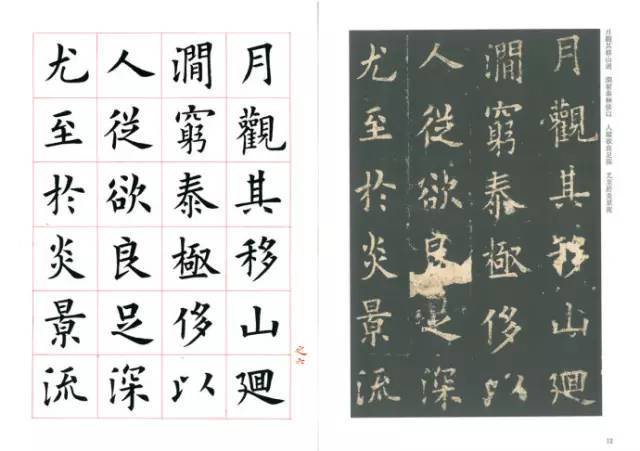
2. Carefully understand how to use a pen
If you carefully observe the "Jiucheng Palace Liquan Inscription", you will find that Ouyang Xun's strokes in this post start and end cleanly, and the strokes between the dots and strokes are used to form echoes. When writing, the writing speed is not fast, but the strokes are decisive and not hesitant. Such use of the pen makes the stipples moist and plump, giving a clear and clear look.
3. Repeated study of structural features
The font of "Jiucheng Palace Liquan Ming" is slightly longer than other regular scripts. The structure of Ouyang Xun's characters is shaped by the characters - if there are few strokes, the font will be slightly smaller and the stipples will be thick; if there are many strokes, the glyphs will be slightly larger and the stipples will be slightly thinner. Careful study will reveal that another obvious feature of the conclusion of "Jiucheng Palace Liquan Ming" is "shrinking the left and extending the right", which is also a manifestation of European calligraphy. Ouyang Xun is known as the "master of structure" in regular script. When tying characters, he on the one hand increased the effect of horizontal strokes with lower left and higher right, and on the other hand increased the degree of sideways of the entire character, resulting in a dangerous structure of European calligraphy.
What is exercised in the practice of reading calligraphy is the close integration of the eyes and the brain. When learning calligraphy, one must develop the habit of reading the calligraphy carefully before writing. If you rush into studying without knowing anything about the model text, you will be blind to the "beauty" in the model text and be at a loss when copying. We should discover the "beauty" in the model posts through "reading", which is the key to increasing interest in writing.
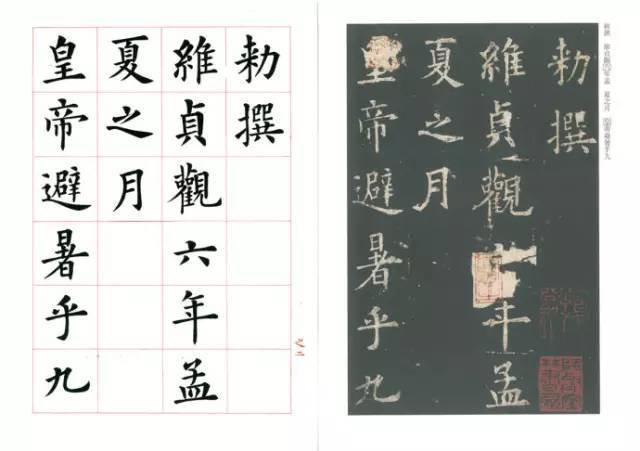
|2|Learning
After the process of reading the post, we immediately came to the stage of learning from the original post. What we need to do in this step is "rational analysis and realistic practice". Only by mastering the brushwork and calligraphy in the model post to the maximum extent can we use it freely in future creations. Linxi can be divided into two steps, first "copying" and then "confronting".
Beginners to learning "Jiucheng Palace Liquan Ming" should start with "Copy Tie". "Copying" is the basic skill of practicing calligraphy, an important process in learning and inheriting the art of calligraphy, and is also the "only way" for beginners to learn regular script. After years of teaching practice, I have summarized an effective "four-step copying method":
1. Select 100 model characters that you think are well written from "Jiucheng Palace Liquan Ming", establish your own "Lin Tie Character Library", and then use photocopying technology to enlarge the model characters one by one to about 10cm in size;
2. Use thin rice paper to cover the enlarged Fan character, and use a very thin pen to double-hook along the edge of the Fan character. The more precise this process is, the better;
3. Use the Zhu Biao color of traditional Chinese painting to fill in the double-hook glyphs like a gongbi painting (note that it is "filling" and not "writing"). The purpose is to allow the writer to carefully appreciate the details of the original post during the coloring process. , this method is called "double hook filling method";
4. Use a brush dipped in ink to describe the pattern on the homemade red characters. This is commonly known as "shadow writing". In this step, in order to save rice paper, the writer can use lighter ink to copy in the first pass, and wait until the rice paper is completely dry. After it is clear, use thicker ink to copy it again.
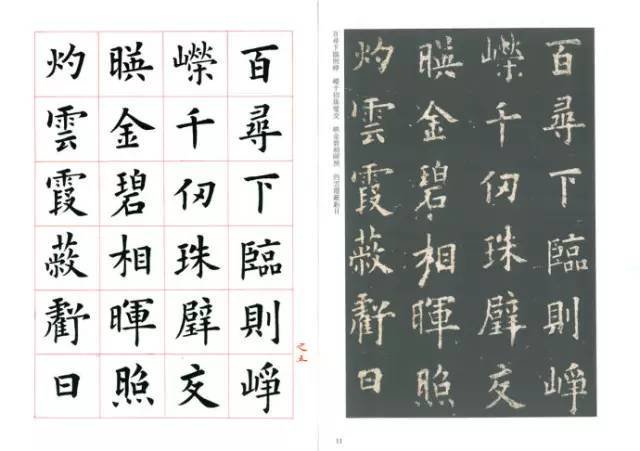
In the initial stage of learning "Jiuchenggong Liquan Ming", the writer's eyesight is limited, so direct copying often ignores one thing and neglects the other. Copying first, focusing the eyes and concentration, can easily achieve the "shape resemblance" requirement.
After beginners have basically mastered the glyph characteristics and writing methods in "Jiucheng Palace Liquan Ming" through copying, they can find some words with similar structures in the original calligraphy based on the 100 characters selected during "copying", and write their own The "Lin Tie character library" is expanded to about 400 characters, and then these characters are classified according to structure and practiced. The writing size is still 10cm square. We place the model characters that we are studying in front of the table. It is best to place them in a position where our eyes can see the model characters and the characters we are writing at the same time. According to the structure, brushwork, posture and meaning of the model characters, on the basis of copying practice , written one by one. In this process, you cannot write randomly, you must concentrate on it, write stroke by stroke, and strive to be realistic! Once you have written these 400 words, you will have basically mastered the writing characteristics and writing methods of "Jiucheng Palace Liquan Ming".
When writing a post, you can choose to use "Tian Zi Ge", "Mi Zi Ge", "Nine Gong Ge", "Hui Mi Ge" and other squares to determine the position of the strokes and the method of arranging the structure of Fan characters to correct personal spontaneous mistakes. eliminate incorrect writing habits and cultivate a well-trained writing awareness and a serious and meticulous learning spirit. After correctly mastering the use of grids to standardize writing, you can remove the grid and compare the writing.
You need to use your mind and heart to think, observe, analyze and compare when writing a post. Through "pro", "like" can be achieved and even "real" can be achieved. Because only through images can we truly learn the method and realize the mystery and true meaning of ancient calligraphy. Only through the presence of images can the writer's observation and eyesight be improved, his ability to control the brush, calligraphy, structure, ink and even composition become stronger and stronger, and his basic skills become more and more solid.
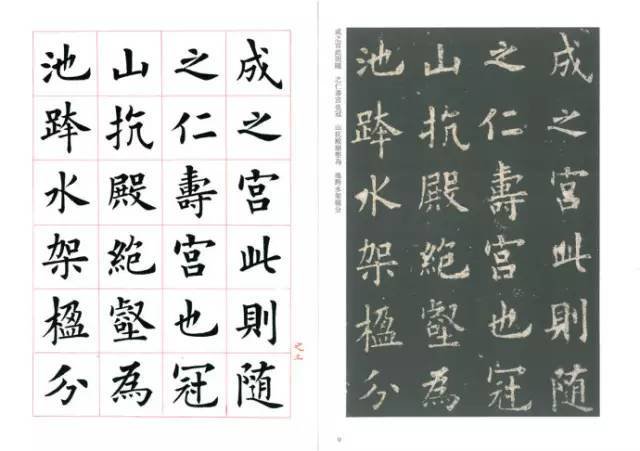
|Three|Memory
Mr. Qi Gong once said: "Kung Fu is not about blindly adding time and quantity, but accurate repetition to achieve proficiency." This tells beginners that there are two things that must be achieved when practicing: one is accuracy, and the other is proficiency. Accuracy is a quality requirement, proficiency is a quantity requirement. If you want to achieve this goal, you must rely on memory. Copying on the premise of memorizing the original copy is the only way to move toward imitation and even creation. It is also an important stage in the process of copying and learning from copying to actual copying.
The overall rules and formations of "Jiucheng Palace Liquan Ming" are strict. Ouyang Xun's writing is full of scheming and artistic conception. He is able to make bold breakthroughs and has unique characteristics in the changes of brushwork, structure and artistic conception. Style and posture. It is precisely because of the obvious characteristics of European regular script that it is easier for beginners to remember, thus creating better conditions for memorizing this post.
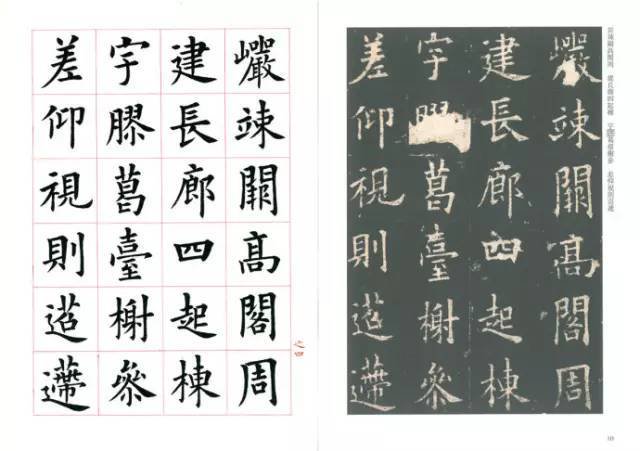
In the practice of calligraphy, "back-to-back" is the method that can best test the memory ability of the calligrapher. We must strive to achieve a lifelike imitation without looking at the original post or copying the model calligraphy. The ultimate requirement of "back-up" is to achieve the point where the imitation post "is not out of shape". This mainly exercises and tests the scholar's proficiency in Fan Zi Shi Lin. Relying on memory, writing model characters silently is the first step towards writing a post. Sun Guoting of the Tang Dynasty mentioned in "Shupu": "Those who observe are more skillful, and those who imitate are more valuable." When memorizing "Jiuchenggong Liquan Inscription", you should pay attention to the combination of silent writing and checking. Silent writing is to rely on memory to write down repeated encounters. After writing the model characters, it is extremely important to check them carefully after writing them. Only in this way can you find out the inappropriate strokes and inaccurate structural positions, and then correct them. The verification must be strict and meticulous.
Many people who are new to "Jiuchenggong Liquan Ming" say that "it is difficult to write" and "the writing is not like it". There are many reasons. In fact, the best way to solve these problems is to "write more and practice more", which requires time and effort. In Kung Fu, you must be able to endure loneliness, endure boredom, calm your mind, stabilize your emotions, and withstand the test. Practice Ouyang Xun's "Jiucheng Palace Liquan Ming". When you can confidently and accurately analyze its brushwork, structure, organization and style characteristics, and can skillfully write characters similar to Fan characters, you can start creating. .
When learning European regular script, you must study the laws of European style, but you must not regard "law" as a dogma and dare not go too far. It must be noted that learning "law" is to use "law" and gradually break it in future calligraphy practice. "Dharma", and finally form your own "Dharma". Su Dongpo said: "My calligraphy is impossible." The "unable" means that his works have broken the established methods of predecessors, while "intentional" means creating works according to his own "method."

